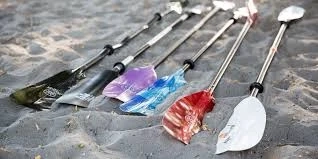Kayaking is a popular outdoor activity that offers a great way to explore the water and get close to nature. Whether you're a beginner or an experienced paddler, choosing the right kayak paddle is essential for a successful and enjoyable kayaking experience. In this guide, we'll take an in-depth look at kayak paddles, including their types, materials, sizing, and maintenance, to help you make an informed decision.
Types of Kayak Paddles
There are several types of kayak paddles, each designed for specific kayaking activities and water conditions. The most common types include:
Touring Paddles: These paddles are versatile and suitable for recreational kayaking and touring. They are typically lightweight and durable, making them ideal for long-distance paddling.
Whitewater Paddles: Whitewater paddles are shorter and sturdier than touring paddles, designed to withstand the rigors of fast-moving water. They often have reinforced blades and shafts to handle the impact of rocks and rapids.
Sea Kayaking Paddles: Sea kayaking paddles are longer than touring paddles, providing better efficiency and control in open water. They are designed for paddling in coastal areas and large bodies of water.
Recreational Paddles: Recreational paddles are entry-level paddles designed for casual kayaking. They are affordable and easy to use, making them ideal for beginners.
Fishing Paddles: Fishing paddles are designed with features such as built-in measuring marks and hook retrieval notches, making them ideal for kayak fishing enthusiasts.
Materials
Kayak paddles are made from a variety of materials, each offering different levels of durability, weight, and performance. Common materials include:
Aluminum: Aluminum paddles are affordable and durable, making them ideal for beginners. However, they are heavier than other materials, which can lead to fatigue during long paddling trips.
Fiberglass: Fiberglass paddles are lightweight and offer excellent performance. They are more expensive than aluminum paddles but are a popular choice among experienced paddlers.
Carbon Fiber: Carbon fiber paddles are the lightest and strongest paddles available. They offer superior performance and are favored by competitive paddlers. However, they are also the most expensive option.
Plastic: Plastic paddles are durable and affordable, making them a good choice for recreational paddling. However, they are heavier than other materials and may not offer the same level of performance.
Sizing
Choosing the right size kayak paddle is crucial for efficient paddling and preventing fatigue. The size of your paddle will depend on your height, the width of your kayak, and your paddling style. Here are some general guidelines for sizing a kayak paddle:
Paddle Length: The length of your paddle should be determined by your height and the width of your kayak. A taller paddler or a wider kayak will require a longer paddle to reach the water comfortably.
Blade Size: The size of the blade can affect your paddling efficiency. Larger blades are more powerful but require more effort to paddle, while smaller blades are easier to paddle but may not provide as much power.
Shaft Size: The shaft size should be comfortable for your hands. Some paddles offer adjustable shafts, allowing you to customize the length for a better fit.
Maintenance
Proper maintenance of your kayak paddle is essential to ensure its longevity and performance. Here are some tips for maintaining your paddle:
Rinse Your Paddle: After each use, rinse your paddle with fresh water to remove any salt or debris that could damage the paddle.
Inspect for Damage: Regularly inspect your paddle for any signs of damage, such as cracks or dents. Replace any damaged parts to prevent further issues.
Store Properly: Store your paddle in a dry, cool place away from direct sunlight to prevent warping or damage.
Use Protection: Use paddle blade covers and shaft protectors when transporting your paddle to prevent damage during transit.
Conclusion
Choosing the right fold up kayak is essential for a comfortable and enjoyable kayaking experience. Consider the type of paddling you'll be doing, the materials and sizing that best suit your needs, and proper maintenance to ensure your paddle lasts for years to come. With the right paddle, you'll be ready to hit the water and explore the world from a new perspective.


